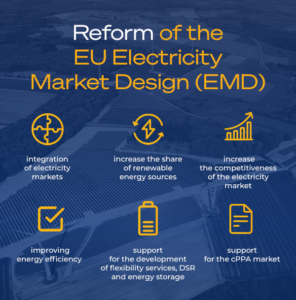New Electricity Market Design
The EU Electricity Market Design (EMD) reform is a new European Union initiative to modernise and improve the functioning of the electricity market in Europe. Its main objectives are:

As envisaged, the development of cPPAs will be based on several initiatives. The first is to increase the share of direct cPPAs in the market structure. It is also important to support the development of legal standards for such contracts.
Another important aspect is the development of bilateral CfDs (Contracts for Difference). The aim of the EMD reform is to clarify how member states can support the development of renewable and low-carbon energy sources by providing predictability of revenues from new investments through bilateral Contracts for Difference (CfDs) (usually for more than 10 years). This type of contract provides greater price stability for consumers, as the charges levied by member states when market prices are higher than the price contracted with generators revert to consumers when prices are high, and vice versa.
The issue of increasing liquidity and developing the futures market (from 3 years forward) cannot be overlooked in order to provide consumers and suppliers with the price benchmark needed to establish a ‘fair price’, as well as enabling better hedging of contracts. The development of futures products based on wind and PV profiles will be particularly important.
Another is to allow consumers to contract directly with green energy producers through energy sharing. The reform concept is to allow energy sharing between active customers to give a wider group of consumers the chance to hedge against volatile prices in the wholesale market and control their energy bills. As a result, cPPAs will become increasingly popular with smaller customers.
The EMD reform also seeks to remove administrative and regulatory barriers in the electricity market. This will bring tangible benefits to companies wishing to enter into cPPAs, eliminate unnecessary restrictions, facilitate negotiations and implementation of these types of agreements. The process of concluding cPPAs will become simpler and more efficient. Currently, the lack of standardised market standards results in a prolonged negotiation process. In addition, there are often significant market changes in the meantime, which reorganise the original expectations of the parties. The introduction of definitions for cPPAs in national legislation will also be key.
The reform also places emphasis on support for innovation and technological development, improved energy efficiency and the development of smart grids. This creates opportunities for companies to engage in innovative energy projects and use advanced technologies under cPPAs. Companies can gain access to cutting-edge solutions that will increase energy efficiency and reduce CO2 emissions.
In conclusion, in line with the EU Electricity Market Design reform, cPPAs will become increasingly important in the contract structure of the market and their popularity in Europe will increase. The directions of the planned changes correspond to the reported needs of generators, and the revenue side and project financing will also be secured. Companies will have more opportunities to use renewable energy and energy price stability will be ensured. The cPPAs will become more standardised and better price benchmarks will facilitate the negotiation process for a fair price for both contracting parties.
Tomasz Bodetko
Head of Origination PST Trade





